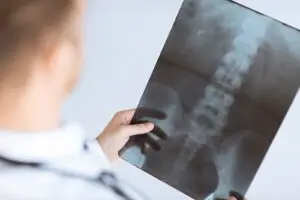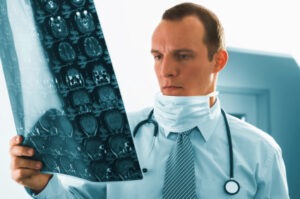
Damage to the spinal cord can completely transform your life, but it all depends on the type of injury and where along the spine you were hurt. Some spinal cord injuries can be fixed with surgery and physical therapy, leaving the victim with no lasting damage. In other cases, it can cause partial to total paralysis from the waist down. When the lumbar portion of the spine is damaged, both are very real possibilities.
What Is the Lumbar Spine?
The spinal column is composed of 33 different bones referred to as vertebrae. These bones stack on top of each other to form the spinal column and give the spine its shape. Within each vertebra is a bundle of nerves that make up the spinal cord, which runs from the brainstem to the lower back. These nerves then connect throughout the body and provide information to the brain.
When one of the vertebra is bruised, fractured, or dislocated or any portion of nerves are damaged, it makes it almost impossible for the nerves to communicate with the brain. This can cause a wide variety of symptoms, from chronic pain to paralysis to even the inability to control your bladder.
The lumbar spine includes five different vertebrae located in the lower back. Together, they control our abilities to bend at the hips, lean backward, turn the torso from side to side, support the upper body, and move the legs. Individually, the lumbar vertebrae include:
- L-1 and L-2: Located at the top of the lumbar spine and below the thoracic spine, L-1 and L-2 work together to control our ability to bend at the hips. Technically speaking, the spinal cord ends at L-1. After this point, the spinal cord splits into a series of nerves called the cauda equina, which extend into the lower body. Because of this, damage below the L-1 is less severe than other spinal cord injuries.
- L-3: The first vertebra to not contain the spinal cord, L-3 controls the upper thighs and allows the knees to bend. If the L-3 is damaged, you may have difficulty straightening or controlling the muscles in your leg.
- L-4: The L-4 vertebra controls several muscles in the legs and feet. While damage is often minor, it can lead to sharp pain or numbness extending from the lower back to the feet and the inability to bend the toes.
- L-5: The lowest segment of the lumbar spine, L-5 has many of the same functions as L-4, and damage to this region can lead to muscle weakness in the legs.
- L-6: While extremely rare, some individuals do have a sixth lumbar vertebra that may cause chronic lower back pain.


Give us a call today to discover how we can assist you.
Common Lumbar Injuries
Even if you have not been involved in a serious accident, such as a vehicle collision or fall, the lumbar vertebrae can suffer minor damage due to poor sitting habits or posture that leads to chronic, but mild lower back pain. In addition, when compared to damage to the thoracic (mid to upper back) or cervical (neck) spine, victims typically do not suffer total paralysis.
That is not to say that lumbar spine injuries are not serious. Each vertebra has an important role in the spinal column and, when damaged, can lead to a variety of medical conditions. With the lumbar spine, these injuries can include:
- Paraplegia, or paralysis below the waist
- Chronic pain that travels from the lower back to the feet
- Numbness in the hips, thighs, and lower legs
- Muscle weakness in the hips, thighs, and lower legs
- Lack of control over the bowels and/or bladder
- Difficulty performing sexually
- Infertility
The level of damage can also vary between cases. Spinal cord injuries can be complete or incomplete. With complete SCIs, the victim often suffers from a total loss of sensation or control below the vertebra that was injured. For incomplete injuries, the victim may have partial sensations or control.
Typically, with incomplete lumbar spine injuries, victims can still live normal lives, even if they suffer from partial palsy. They may need assisted living equipment such as a wheelchair or bracers, but they can generally live independent lives. However, there is still a hefty price to pay for their treatment. Alongside emergency medical treatment for the initial injury, they may require follow-up surgeries to correct any lasting damage, hospitalization, physical therapy, medical equipment, and a catheter. All of this can add up to hundreds of thousands of dollars in medical bills.
Besides medical expenses, any disabilities or chronic pain may make it difficult for them to continue working at their normal jobs. They may need to reduce their work hours, change careers, or train in a new specialty. That also does not include the physical and mental pain they will have to deal with following their treatment.
If your spinal cord injury was caused by someone else’s negligence, such as a distracted driver, slipshod business owner, or careless homeowner, you may be able to recover compensation in a personal injury claim. At DiBella Law Offices, P.C., our lead Burlington personal injury attorney has more than 15 years of experience representing clients who have suffered catastrophic spinal cord injuries and achieving positive case results. Our firm can thoroughly review your case in a free consultation and aggressively negotiate for proper compensation for your injuries. To discuss your claim further, contact our office at (781) 262-3338 and schedule an appointment with a skilled legal team.


We are committed to providing valuable information and resources to assist you.





